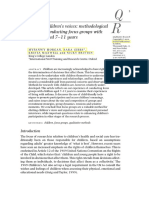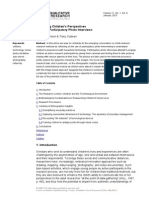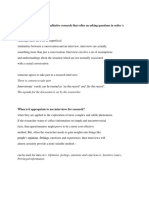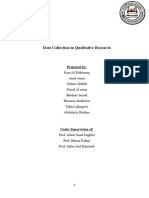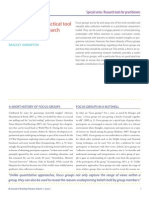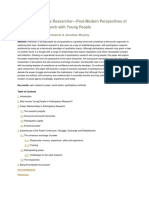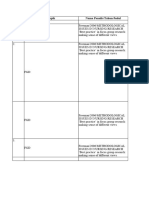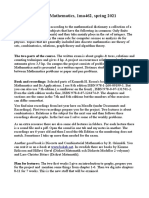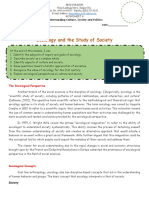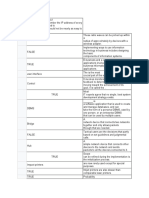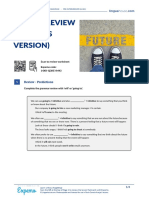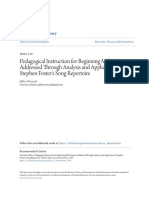FAQ 3: When is it good to use focus group, in-depth interviews,
and observations?
What’s the issue?
You have taken a decision that you will conduct a qualitative data collection, but which method do you choose?
Do you want to observe a particular group or site for a long period in order to discover how meanings,
representations, and behaviour come about? Or would a group where participants share and compare their
experience be better? Perhaps you are dealing with specific and sensitive issues and would rather conduct in-
depth interviews?
Common practice
In-depth interviews and focus groups can be used as part of a mixed methods research strategy (e.g. as a
complementary method to a survey). Each one, however, can be used as a research method in its own right,
which produces specific findings (qualitative), entails different sampling criteria, and certain basic rules. In
fact, researchers have developed a range of techniques and several strategies for working with groups of
children and young people.
These include using visual retrieval aids for recall, asking “why” questions (who/what/when/where/why)
rather than yes/no questions, and open-ended rather than closed questions, and explaining that “I don’t
know” is an acceptable reply (to reduce response biases) (see Lobe et al., 2007).
As a general rule, in-depth interviews are best when you are interested in individual experience, perceptions,
and feelings, regarding several topics of interest that can only be attained through an informal conversation
alone with a child informant. Thus, they are particularly suitable when investigating sensitive issues such as
risky online experiences. On the other hand, focus groups are best when you want to consider not only
children’s own accounts of reality, but the way they negotiate these accounts with others, therefore showing
divergence or convergence between their views.
Focus groups can be used to examine children’s practices, perceptions, and beliefs in the context of their
peer-related activities, thus uncovering meanings and feelings, shared representations, specific topics that
children of the same age talk about, and, more specifically, how they communicate about their media and
internet interests and experiences. Often, media use and content is selected, assigned significance, and
interpreted through social interaction within groups. The dynamics of children’s peer groups can be at least
partly captured and reproduced within focus groups.
In a focus group design, social interaction between participants is the core issue. The researcher should
encourage and observe discussions between individuals. Being able to collect the information needed while
observing interaction amongst participants is an obvious benefit of conducting a focus group.
Since focus groups are based on social interaction, the context within which that interaction takes place is of
the utmost importance. Focus groups can be conducted in informal peer group settings, and in classroom
situations, as well as at home. The location of the research matters to children (and, no doubt, to adults), and
should be familiar to the child. In this particular sense, focus groups are more similar to “natural groups” (i.e.,
pre-existing social groups, such as friends, class mates, families, etc.) than to “artificial groups” (usually
assembled by marketing researchers), including people who don’t necessarily know each other (and are
actually not supposed to).
Researchers have pointed to a number of reasons for using online focus groups, namely, the speed, ease,
and low cost of computer-mediated social research. Moreover, as already highlighted in the first age of the
internet studies, being anonymous promotes self-disclosure related to sensitive issues, thus reducing
difficulties of disclosure with peers in a face-to-face context. However, online focus groups raise ethical
considerations: in particular, traditional ethical guidelines need to be revisited, also taking into account codes
of conduct relating to online behaviour. A limitation of using online focus groups with younger children is that
developing a rapport between interviewer and interviewees is more difficult and takes longer than face-to-
face interaction.
Observation may be a part of other methods (e.g. occurring during focus groups) or be employed as an
independent or alternative method. Participant observation of children’s playing falls into this last category. It
may also be part of an experimental design, based on systematic observation. When researching very young
� children, this last procedure may prove to be particularly adequate, since children could reject other
methods, or they may simply be inappropriate for certain ages.
When investigating children’s online experiences, researchers could also engage in forms of “virtual
ethnography” or “virtual shadowing”, following the informant or the natural group in their online interactions.
This method raises important ethical issues, however: not only must children be informed, but they also need
to give their consent. One possibility is to ask children about the digital outputs of their daily media practices,
such as daily digital accounts or diaries.
Questions to consider
Any research interaction with children should allow sufficient time for “warming up” and developing a rapport with
the children. It is also important to arrange for more than one meeting in order to gain the child’s trust, especially
in the case of in-depth interviews on sensitive issues. Furthermore, the research process should be varied as a
child’s concentration span calls for variety in approaches (mixing methods, shifting focus, introducing varied
materials).
Media use and content is often selected, assigned significance, and interpreted through social interaction within
peer groups. The dynamics of children’s peer groups can be at least partly captured and reproduced within focus
groups.
Several basic strategies have been noticed by authors who have worked with children in focus groups (Morgan et
al., 2002): care in the recruitment and composition of the group (4–5 children is probably best, as is separating
boys and girls for older children); achieving a balance of power that enables spontaneous contributions; setting
the scene to encourage informality and participation, specifying ground rules, and structured warm-up activities;
managing space and time by breaking up the session, varying the activities, and arranging the space; accessing
children’s meanings through appropriate prompts and probing; use of an alternative personality (e.g. a stuffed toy
or cartoon character to take the place of the interviewer); pen-and-paper exercises, especially for drawing or for
producing a shared image; role-playing scenarios with dolls, toys, or the children themselves; and observing the
group dynamics, tensions, and sensitive moments (Irwin & Johnson, 2005; Lewis, 1992).
Pitfalls to avoid
Regarding the role assigned to children in an interview, it is important to treat them as active participants, rather
than as mere respondents, giving them the opportunity to explain their responses in the interviewing process.
Children must not get the feeling that they have to give the “right” answers.
Interviews, individual or collective, are the result of a given social process, which means they are not simply
“neutral” conversations between two or more individuals. In this sense, all information is the result of a particular
social relation between interviewer and interviewee. The context in which the interview takes place, the roles that
are assigned to participants, the individual characteristics of participants (both interviewer and interviewee) – all
influence the kind of relationship established and the nature of the information gathered.
Although focus groups add to in-depth interviews the possibility of observing group dynamics, they could be
restrictive if the intention is to explore certain topics related to single individuals. This is particularly the case
when dealing with children or young people.
Be aware of the number of participants in focus groups – having more participants will not make the data more
generalizable.
A researcher’s experience
Natural groups are one of the most appropriate methods to investigate children and their media uses. One
of their main advantages is the opportunity for the researcher to observe social interaction in its natural
setting and, as far as children’s use of online technologies are concerned, observe how practices of use
are defined, negotiated, and shaped within social networks and peer relations. In contrast, focus groups
organized through recruitment agencies can introduce a significant bias, since many recruitment agencies
now make use of ‘professional focus groupers’, that is, people (even teenagers and younger children) who
� are used to joining several focus groups per year, and who also sometimes specialize in talking about
certain topics (such as media consumption). However, natural groups may also pose some challenges to
the researcher because the group observed is characterized by established relationships, certain roles,
and relations of power within the group that the researcher has to identify and bear in mind. Another side
effect of the study of pre-existing social networks is the fact that they tend to share a common experience
expressed in terms that are largely taken for granted and unfamiliar to the researcher. This aspect,
though, may be peculiar to all focus groups on children, since they tend to speak their ‘own’ language and
perceive the researcher (independently of age, in/formal look, etc.) as a stranger, too odd to understand
what they are speaking about. This was the case of one research project where the group was comprised
of two boys and two girls aged 14 and 15, two of whom had been boy- and girlfriend. The two kept on
flirting during the interview, much to the great disappointment of the other girl who was seemingly jealous
of her friend. The interview was somewhat hard to manage, especially when the group was asked to tell
and show what kind of texts and MMS [Multimedia Messaging Service] they used to exchange, since most
of this was related to the previous ‘affair’ between them. (Giovanna Mascheroni, Italy)
References and further resources
Christensen, P. & James, A. (eds) (2001). Research with children. London: Falmer Press.
Clark, A. (2011). Multimodal map making with young children: exploring ethnographic and participatory methods.
Qualitative Research, 11(311), 311–330.
Fielding, M., Lee, R.M., & Blank, G. (2008). The Sage handbook of online research methods. London: Sage
Publications.
Greene, S. & Hogan, D. (2005). Researching children's experiences: Methods and approaches. London: Sage
Publications.
Hennessy, E. & Heary, C. (2005). Exploring children’s views through focus groups. In S. Greene & D. Hogan
(eds) Researching children's experience (pp. 236–252). London: Sage Publications.
Irwin, L. G. & Johnson, J. (2005). Interviewing young children: Explicating our practices and dilemmas.
Qualitative Health Research, 15(7), 821–831.
Lewis, A. (1992). Group child interviews as a research tool. British Educational Research Journal, 18(4), 413–
421.
Literat, I. (2012). Participatory drawing as a visual research method with children and youth. Paper presented at
the Children, Adolescents and the Media Division for the annual International Communication Association
Conference in Phoenix, Arizona.
Lobe, B., Livingstone, S., & Haddon, L. (eds) (2007). Researching children’s experiences online across countries:
Issues and problems in methodology. London: EU Kids Online, LSE.
Morgan, D. & Krueger, R. A (eds) (1998). The focus group kit. London: Sage Publications.
Morgan, M., Gibbs, S., Maxwell, K., & Britten, N. (2002). Hearing children’s voices: Methodological issues in
conducting focus groups with children aged 7–11 years. Qualitative Research, 2(1), 5–20.
Stewart, K. & Williams, M. (2005) Researching online populations: the use of online focus groups for social
research. Qualitative Research 5(4): 395–416.






























